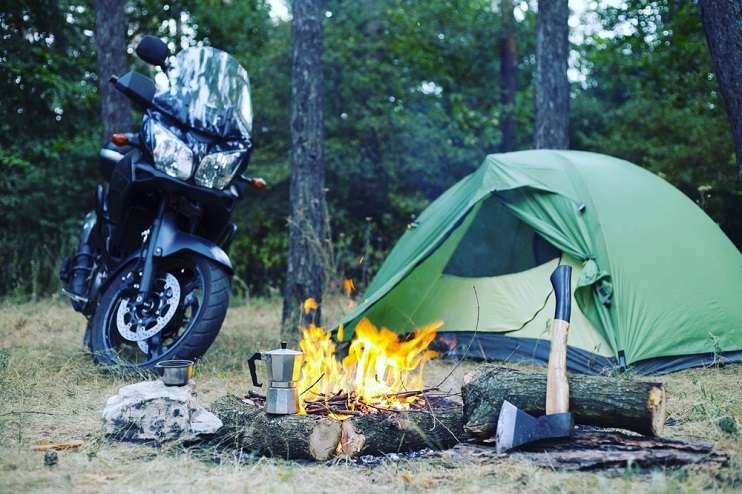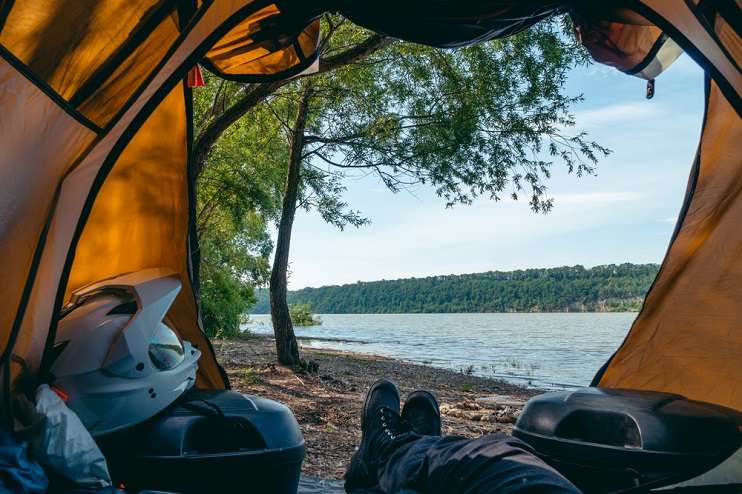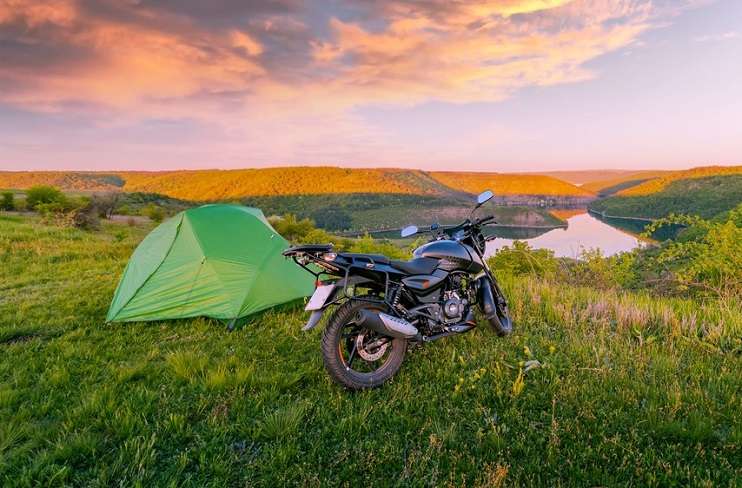You’re probably used to taking your motorcycle for weekend cruises, daily errands, and the average commute. However, you might not have taken it camping. If that’s the case, you’re missing out on one of the most personal and freeing experiences a biker can have.
Motorcycle camping takes two amazing pastimes, riding and camping, and blends them into one experience that elevates what either can be on their own.
So, we want to drop this ultimate motorcycle camping guide and help you experience the adventure of a lifetime.
Let’s get started.
What is Motorcycle Camping?
Motorcycle camping is pretty self-explanatory. It’s when you pack up your gear, load it up on your bike, and hit the open road until you finally set up camp and enjoy the great outdoors. However, some inherent challenges come with motorcycle camping that makes it such a freeing experience.
First and foremost, you obviously won’t be “glamping.” Even if you have expanded storage options, you’re not bringing a big, 6-person tent. You’re not bringing big, fancy camping beds, generators, and everything else that many modern campers insist on bringing along. You have to make the most out of what little space you have on your bike, which means giving up on a few modern advances.
However, those limitations, coupled with the fact that you’re riding your bike right up to your camping spot, enhance the overall experience by dumbing it down a bit and keeping it simple. It provides more of a connection with the world around you, and it engages you more than if you were to practically drag your entire house along with you.
This is primarily why motorcycle camping is such an attractive getaway from the day-to-day stresses of life.
Motorcycle Camping Tips: Getting the Basics Down
First, we want to go over the more basic tips that every rider needs to have a good grasp on before they consider heading out on the trail for a weekend of adventure. Then, we’ll go over the more advanced stuff.
Focusing on the Essentials:
This is probably the most important aspect of motorcycle camping that you need to grasp very quickly. We mentioned it earlier; you don’t have a lot of space.
A motorcycle doesn’t have the space that a car or a pickup has, and that means the type and number of things you can carry is pretty limited. Assuming you’re using a pretty standard setup with a main rear saddlebag, a couple of saddlebags, and maybe a backpack, you’ll have just enough room for the absolute essentials and perhaps a couple of small luxury items.
When getting your gear together, you need to focus on those essentials if you want to have a good time. Take into account where you’re going and what obstacles you’re likely to face.
Are you staying at a well-developed campground with modern commodities and a little general store? You can focus more on equipping yourself for the ride and stuffing some more comfort-based items into your kit.
Are you camping in the middle of a mountain range with a temperate climate and no nearby civilization? It’s probably better to focus on securing safe drinking water, ensuring your shelter is enough to protect you from the elements, packing compact, high-calorie foods, and maybe even a bit of protection if you’re somewhere with larger predators around.
Given the vast number of ways you camp, you should do some research on your destination and what’s necessary to do well out in the elements there.
Skill Prep:
Of course, you can pack the perfect gear, head off to a remote area, and still end up in a sticky spot if you have no idea how to use your equipment or how to manipulate your environment to suit your needs effectively. Your brain is your most important piece of cargo when you head out for some motorcycle camping adventures.
With that being said, you need to put in some time before you go camping to make sure you’re mentally equipped to handle anything that comes at you.

Do you know how to find a water source and properly purify it for drinking? Can you use a LifeStraw properly? How can you make a roaring campfire when your lighter is wet and not working? How about performing basic medical care on yourself until you get proper help? These are basic safety skills you need to know before you even start planning your trip. Of course, it’s not as big of a deal at a modern campsite, but it’s a make-it-or-break-it kind of thing for more remote camping.
Then there are camping skills you need to know, such as building a tent. You won’t have the room for a giant popup tent, and it’s pretty common for bikers to bring good old tarp tents with them for motorcycle camping. These aren’t hard to build, and you just need a tarp and some sticks. Some setups are designed to suspend the tarp from nearby trees to create a sort of awning for protection from the rain. The more setups you learn, the more situations you can adapt to with less equipment.
Other skills include fishing, outdoor cooking, and various other outdoor skills that not only ensure your safety but also enhance the experience overall.
Understanding Local Camping Laws:
Your bike provides you with a lot of freedom when camping, but the law doesn’t. You can’t just pull over on the highway, toss up a tent, and not expect the cops to raise an issue about it. You can camp in obvious spots such as campgrounds that charge a fee, but you can also camp freely in most national parks and on unowned, remote land, most places. Take a short time to research the area you want to camp in and learn about the laws and regulations that might affect your camping trip. You won’t want to get the setup just to have a wildlife ranger force you out of the area with a fine.
On top of that, there are circumstantial and area-specific regulations you need to know about. If an area has been in a drought, the state or local authorities may issue a fire ban. This can be problematic if you’re wilderness camping, and you’ll have to prepare accordingly. There might also be regulations on water sources, how long you can stay in one spot, shelter limitations, and more. Make sure to check for those kinds of rules before your trip, and if you have any questions you can’t find answers to, call the state’s wildlife branch to get information straight from the source.
Finally, you may need to acquire licenses for some of the activities you might do while motorcycle camping. If you plan on fishing in a new state, your home state’s fishing license isn’t valid. You’ll need to stop by a bait shop or appropriate retailer to get a fishing license in the state you’re visiting. If you need to carry protection to fend off wildlife that becomes dangerous, you might need more approval in a different state, or your preferred protection might be banned outright.
Safety:
Your safety is at risk when you camp in remote areas, and you won’t have immediate access to civil services such as police and EMTs. You’ll have to rely on yourself. So, here are the very basic safety tips you need to understand before hitting the road.
- Communicate: Ensure at least two trustworthy people know where you’re going, how long you plan to stay, and when they can expect you back. If you don’t show up or call to explain it, they know to call the police.
- Gear: Your smartphone should be on you at all times, but it can lose signal in some remote situations. Try investing in a satellite phone meant explicitly for making calls in areas where phones usually don’t have a signal.
- Mapping: Blindly exploring an area can lead to dangerous, or even life-threatening, mistakes. You might get lost miles away from your bike, unwittingly walk into a hazardous area, or otherwise get in a sticky situation. Make sure you have a map or motorcycle GPS tracker to keep you on track.
Specific Tips for Motorcycle Camping
Alright, we’ve covered the bare essentials. Now, we want to talk about some more specific things that will make your adventure a bit more eventful or safer.

Bring a Rod:
Fishing embodies the camping spirit, and it’s the perfect activity to plan for your fishing trip. It only requires a local fishing license, and your gear is simple enough for anybody to have fun with it, and it can even supplement your food supply.
However, it’s challenging to fit a seven-foot jigging rod on a motorcycle like you would for an ordinary fishing trip. Instead, check out one of the many travel rods on the market. These telescoping rods pack up small and sacrifice a little performance, but they’re plenty good enough for a little mid-camping fun. We recommend UglyStik’s new travel set for its durability, compact stature, and decent performance in comparison to other options in its price range. For $40, you really can’t beat it.
Get a Lifestraw:
You can’t pack gallons and gallons of water on the back of your bike, and if you’re going to a more remote camping spot, natural water will be essential. However, you probably already know that drinking straight from natural water sources isn’t great.
You can easily use the traditional method and do your best to filter the water before boiling it in a lightweight cooking set. Alternatively, there’s a faster, less laborious way to get water straight from nature; you can get a Lifestraw – travel water filter.
Lifestraws were made to be deployed in impoverished countries that struggle with maintaining clean drinking water. A Lifestraw looks just like a fat drinking straw. You stick one end in the water, and you suck on the other end. Built-in filters remove contaminants and make the water safe to drink without boiling or even collecting it. Some models even have pumps to help you fill your water bottles directly from the source.
Sawyer makes these, and they’ve been proven to be highly reliable while filtering thousands of gallons of water; not to mention, they’re pretty cheap.
Invest in a Sidecar:
The main hurdle of motorcycle camping is dealing with the lack of storage space for bringing gear along. You can solve that, at least to an extent, by investing in a sidecar for your motorcycle. Some options function as add-on trunks, passenger seats, or even a combination of both. Find one that suits your needs and can secure more gear, and you’ll have more to work with when you go camping.
Start Small:
If this is your first-time camping, don’t feel pressured to take the rugged route and head right off into the wilderness or the middle of the Arizona desert. That’s a bit dangerous for solo beginners. Instead, consider renting a spot at a well-kept campground that will allow you to work on your skills a bit, have fun, and enjoy the trip. Plan more remote trips to national parks and similar areas as you get more comfortable.
High-End Shelter the Easy Way:
As we said earlier, modern tents will be challenging to pack on a motorcycle, and even if you succeed, you will likely have to sacrifice several other valuable items to do it. So, a traditional tarp tent you can set up with sticks or pre-purchased stakes and rope is usually the better way to go.
Don’t go cheap on this.You can grab a $10 tarp from a discount tool start and get through a calm spring evening, but what about a raging storm in the middle of the summer heat? Spend a little more money on a waterproof canvas tarp that can resist harsh conditions. These also tend to be a lot bigger when unfolded. So, you can make larger shelters.
Of course, think of the shelter for your bike as the weather can be unpredictable – so don’t forget to bring your motorcycle storage as well!
Have Fun on Your Next Motorcycle Camping Adventure
Finally, it’s time for you to get out there and embrace the adventure of motorcycle camping. Remember to have fun and de-stress a bit for one last piece of advice. That’s the whole point of riding and camping.
As always, you can find more motorcycle information at TheMotorBiker to get you on the road and enjoying the ride.


